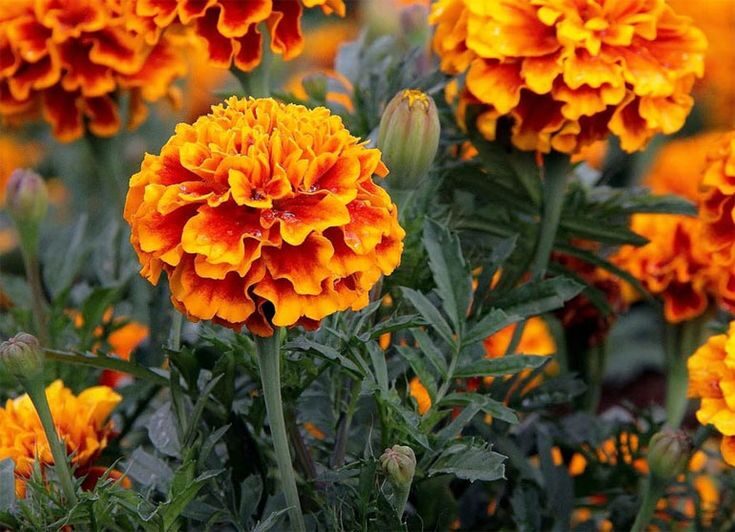How to grow marigolds in your garden in Germany – a complete guide with prices

Marigolds, botanically known as Tagetes, are among the most practical and rewarding flowers to grow in Germany. They bloom from late spring until the first autumn frosts, brightening gardens, balconies, and allotments with vivid shades of gold, orange, and yellow. Their strong aroma naturally repels common pests such as aphids, whiteflies, and nematodes, making them a valuable companion plant in both ornamental and vegetable gardens. Low maintenance and drought-tolerant, marigolds are ideal for gardeners of all experience levels. They also self-seed easily, allowing you to save seeds for the following season. This guide from G.business covers everything you need — from sowing to seed collection — plus current prices and where to buy marigolds in Germany.
Why marigolds are a must-have in German gardens
Marigolds are appreciated for their long flowering period, natural pest control, and adaptability to different climates — from the warmer regions of Baden-Württemberg to cooler coastal areas in Schleswig-Holstein. They grow best in full sun but can tolerate light shade, making them versatile for urban balconies and rural gardens alike. In organic gardening, German hobbyists often plant marigolds alongside tomatoes, potatoes, beans, and carrots to reduce pest populations. They also attract pollinators like bees, hoverflies, and butterflies, which are essential for biodiversity.
Step-by-step planting guide for marigolds in Germany
1. Choose the right location
Select a sunny position, as marigolds produce the most flowers when they receive at least 6–8 hours of direct sunlight daily. In southern Germany, a location with light afternoon shade can protect them from excessive heat, while in the north, maximum sun exposure is recommended.
2. Prepare the soil
Loosen the soil to a depth of 20 cm and mix in compost or a slow-release organic fertiliser. In regions with heavy clay soil (common in Bavaria), add sand or fine gravel to improve drainage.
3. Decide on sowing or planting
- From seeds indoors: Start in mid- to late April in seed trays or small pots, keeping the temperature around 18–20°C.
- Direct sowing outdoors: Wait until mid-May, when night temperatures consistently stay above 10°C.
- Buying seedlings: Garden centres across Germany begin selling ready-to-plant marigolds from late April.
4. Plant with proper spacing
Space compact varieties 20 cm apart and tall varieties up to 30 cm apart. This prevents overcrowding and reduces the risk of fungal diseases, especially in humid regions like Hamburg or Bremen.
5. Watering routine
Keep the soil evenly moist in the first two weeks after planting. Once established, water deeply only during dry spells. Avoid wetting the foliage in cooler weather to prevent mildew.
6. Ongoing care
Deadhead faded blooms regularly to encourage continuous flowering until October. In June and August, feed with a liquid fertiliser to maintain strong growth and vivid colours.
7. Preparing for next season
In September or October, select a few healthy flowers to dry on the plant. Collect the seeds, label them, and store them in a paper envelope in a cool, dry place for the next planting season.
Popular marigold varieties in Germany and their uses
- Studentenblume hoch (African marigold, Tagetes erecta) – Tall, large blooms, ideal for flower beds and allotments.
- Studentenblume niedrig (French marigold, Tagetes patula) – Compact, perfect for balcony boxes and borders.
- Feinblättrige Studentenblume (Signet marigold, Tagetes tenuifolia) – Fine foliage, great for rock gardens and edging.

Table – Popular marigold varieties
| German name | Height | Flower colour | Blooming period | Best use |
|---|---|---|---|---|
| Studentenblume hoch (T. erecta) | 50–80 cm | orange | June – October | Beds, vegetable gardens |
| Studentenblume niedrig (T. patula) | 20–40 cm | yellow, orange | June – October | Pots, borders |
| Feinblättrige Studentenblume (T. tenuifolia) | 15–30 cm | yellow | June – October | Balconies, rock gardens |
Prices and where to buy marigolds in Germany
Marigolds (Studentenblumen) are available in garden centres, hardware stores with garden sections, and even supermarkets during planting season. Prices vary depending on size, variety, and whether you buy seeds or ready-to-plant seedlings.
| Product type | Price (€) | Store / Chain | Example address |
|---|---|---|---|
| Seeds (1–2 g pack) | 0.99 – 1.49 | OBI | Prenzlauer Promenade 20, Berlin |
| Seeds (1–2 g pack) | 1.20 – 1.80 | Dehner Gartencenter | Landsberger Allee 360, Berlin |
| Seedling (per plant) | 1.50 – 3.00 | Bauhaus | Beusselstraße 44N, Berlin |
| Seedling (per plant) | 2.00 – 3.50 | toom Baumarkt | Märkische Allee 300, Berlin |
| 12 cm potted plant | 3.50 – 5.00 | Dehner Gartencenter | Landsberger Allee 360, Berlin |
| Tray of 6 seedlings | 6.50 – 9.50 | OBI | Prenzlauer Promenade 20, Berlin |
Care tips for long-lasting blooms in Germany
For the best results, place marigolds in sunny spots, water during prolonged dry periods, and feed monthly with a balanced fertiliser. Avoid waterlogging, as Germany’s wetter regions in the north can lead to root rot. On balconies, ensure pots have proper drainage holes. Combining marigolds with herbs like basil or rosemary not only improves aesthetics but also increases pest-repelling power.
Stay connected for news that works — timely, factual, and free from opinion — and insights that matter now: How to grow hydrangeas in your garden in Germany — a complete guide for beginners.